How we test - Incinerating toilets
What is an electric incinerating toilet?
An electric incinerating toilet is a toilet in which urine, faeces and toilet paper are incinerated at high temperature. The incineration process heats the waste to a temperature of 500 – 600 °C. The gases produced are vented through a flue pipe. The oxygen supply for combustion is taken either from the indoor space or direct from outside. A fan is fitted to the toilets to ensure that the flue gases are vented. After the incineration process, the ashes are collected in an incineration chamber (ash pan). Incineration is efficient, and the quantity of ash produced is limited, which means that it will probably not be necessary to empty the ash pan more than once a week in normal use.
The documentation of the testing procedure is derived from a mission test from 2018.
The selection criteria were incinerating toilets which require a maximum 10 A main fuse (maximum power of approximately 2,000 W).
The laboratory test
The laboratory test covered the following main elements:
1. Safety
A. Electrical safety
B. Functional safety
2. Capacity
A. Single flush (cold start)
B. Three flushes in a row (10 minutes between each)
C. Three double flushes in a row (10 minutes between each double flush)
D. Air consumption
3. Installation
A. Instructions
B. Components included
4. User-friendliness
A. Operating instructions
B. Using the toilet (Positioning the bowl liner and flushing)
C. Cleaning the seat and bowl
D. Emptying the ash pan
E. Indicators and signal system
5. Construction quality
1. Safety
A. Electrical safety
The laboratory carried out a limited electrical safety evaluation of the toilets, in accordance with Standard EN60335-2-84:2003. All toilets received minor or serious criticism in relation to electrical safety. The most serious criticism was reserved for the two Separett toilets, where there is a risk of the user coming into contact with electrically live components behind the ash pan. Other toilets were criticised for the way the cable was run or a lack of certain safety information in the owner’s manual.
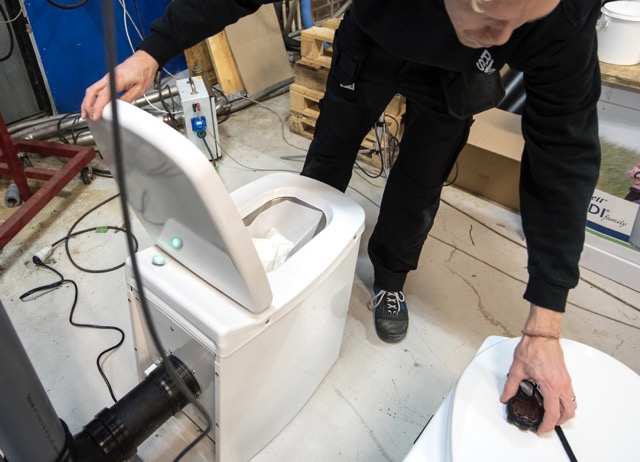
B. Functional safety
The following functions and elements were included in the evaluation:
-
Can the hatch to the combustion chamber be opened during incineration? If it is possible to open the hatch to the combustion chamber during incineration, there is a risk of the user coming into contact with an open flame. Cinderella is the only toilet with a function which locks the hatch to the combustion chamber if the toilet seat is in the open position.
-
Is there a risk that children will gain access to the ash pan? All of the toilets have a satisfactory security lock on the hatch to the ash pan.
-
Can the ash pan be removed during incineration? All of the toilets shut down combustion if the ash pan is removed during the combustion process, but the temperature in the combustion chamber remains high.
-
Can combustion be started without the ash pan or if the ash pan is in the wrong position? All of the toilets apart from the Cinderella start combustion even if the ash pan is not in place or is in the wrong position. Bear in mind that the high temperature (500 - 600 °C) can cause damage to underlying material (floor), with a risk of fire.
-
Risk of users burning themselves on the outside of the toilet (outer temperature of the toilet)? With none of the toilets was the temperature on the outside dangerously high.
-
Are the necessary safety labels for burn risk/hot surfaces displayed? The Cinderella is the only toilet with warning labels for hot surfaces on the hatch to the ash pan. The labels are, however, displayed on the inside of the hatch, which is not optimal.
-
What happens if the hatch to the combustion chamber is blocked and cannot be closed? The Cinderella is the only toilet which alerts the user if the hatch is blocked. The other toilets start combustion even if the hatch is partly open, which means that heat and combustion gases can escape through the hatch to the toilet.
-
What happens to the combustion gases in the event of a failure in the electricity supply? The Cinderella and the Separett (both models) are the only toilets which have a battery backup which can power the fan in the event of a power failure. With the other toilets, the fan stopped in the event of a power failure, and some of the combustion gases leaked out via the toilet seat and the back of the toilet. The toilets do, however, have a good natural draft, so that the majority of the gases are drawn out through the flue pipe.
2. Capacity
The capacity test was carried out in three parts.
- Single flush from a cold start, which simulates one person using the toilet on one occasion, without any subsequent use.
- Triple flush, which simulates a toilet queue of three persons who flush the toilet at 10 minute intervals.
-
Three double flushes, which simulates six persons going to the toilet, with 10 intervals between each double flush.
For each flush, 150 g of synthetic faeces, 250 g of synthetic urine and 10 g of toilet paper were added. The faeces were manufactured in accordance with the formula developed by Pollution Research Group at University of KwaZulu‐Natal in South Africa. The formula was based on research into testing toilets for spacecraft, and is used, among others, by the Bill & Melinda Gates Foundation for evaluating new toilet technologies. The faeces contain the following components: yeast, psyllium husks, peanut oil, miso-paste, polyethylene glycol, potassium phosphate, cellulose and water.
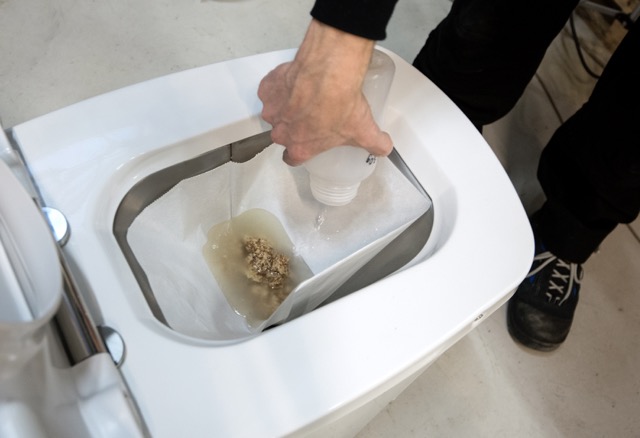
The synthetic urine was manufactured in accordance with the formula in Nordisk Miljömerking’s [the Nordic Environmental Foundation] ”Test method for closed toilet systems”.
Single flush (cold start)
All the toilets successfully managed full incineration of one flush with ash residue weighing around 17 g. The Cinderella Comfort recorded the fastest incineration at 56 minutes, followed by the Sunwind at 60 minutes. The slowest was the Separett Cindy at 89 minutes. The Cinderella Comfort had the lowest energy consumption at 1.41 kWh, followed by the Incinolett at 1.42 kWh. The highest energy consumption was recorded for the Separett Cindy at 1.90 kWh.
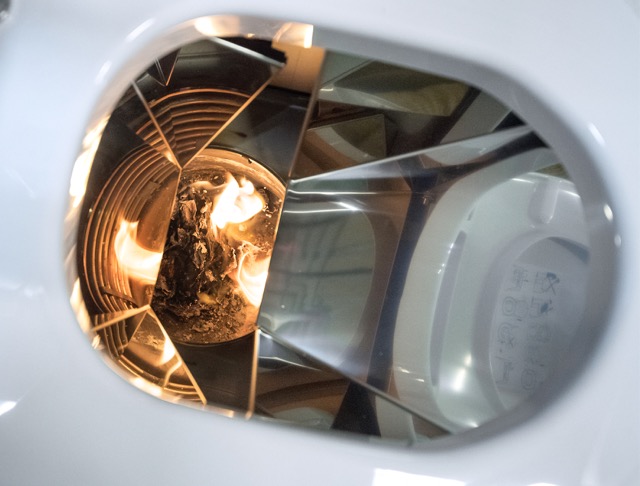
Three flushes at 10 minute intervals
The Cinderella Comfort and both of the Separett toilets successfully managed full incineration with ash residue weighing around 48 g. The Cinderella Comfort was fastest, at 132 minutes. The two Separett toilets took around 210 minutes. The Cinderella Comfort had the lowest energy consumption at 2.72 kWh, compared with 4.22 and 4.01 kWh respectively for the two Separett toilets. The Incinolet and the Sunwind did not manage full incineration. They left 217 and 232 g of residue from a total of 1,230 g of faeces and urine. To achieve full incineration, these toilets would have to be restarted.
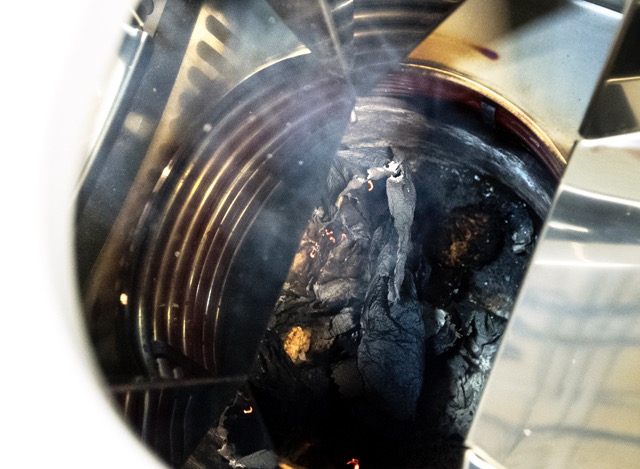
Three double flushes at 10 minute intervals
The Cinderella Comfort and both of the Separett toilets successfully managed full incineration with ash residue weighing around 100 g. The Cinderella Comfort was fastest at 204 minutes. The Separett Flame and Cindy took 359 and 242 minutes respectively. The Cinderella Comfort had the lowest energy consumption at 4.02 kWh, compared with 6.99 and 5.04 kWh respectively for the Separett Flame and Cindy. The Incinolet and the Sunwind did not manage anywhere near full incineration. They left 1,110 and 1,230 g of residue from a total of 2,460 g of faeces and urine. To achieve full incineration, it is likely that these toilets would have to be restarted more than once.
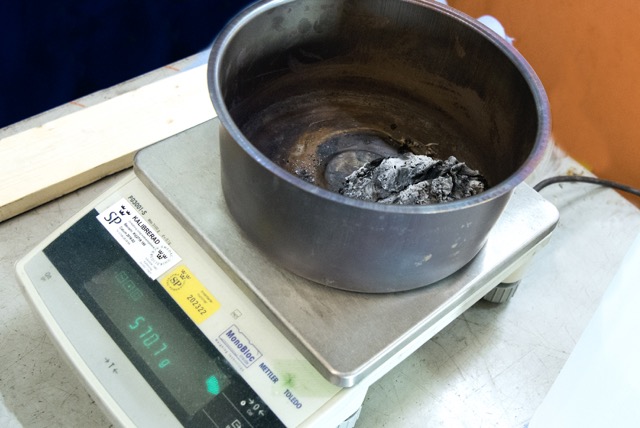
Air consumption
The Cinderella Comfort was the only toilet which takes air from outside the building. The others take air from the room (from within the house). During the capacity test, the Cinderella Comfort took in outdoor air at 6°C, and the others took indoor air at 18 - 20°C. Despite this temperature difference, the Cinderella Comfort had the lowest energy consumption during incineration. The toilets which take air from the room (from within the house) may have a significant impact on the indoor climate. During the incineration of a single flush, the Incinolet and the Sunwind drew in 157 m3 of air. To prevent warm air being drawn out of the house, adequate ventilation is required in the bathroom to enable efficient combustion to take place. Converted to energy consumption, it takes around 1.3 kWh to heat 160 m3 of air from, for example, -10 °C to +15°C.
3. Installation
All of the toilets can be connected using plugs to standard wall sockets (220-230V), and do not require more than a 10A main fuse. Connecting flues and ensuring ventilation are an important and demanding aspect of the installation.
If the flue or ventilation is connected incorrectly, the toilet will not function optimally, and, in the worst-case scenario, combustion gases can escape into the room.
Installation
Provided that a wall socket is available, any normal handy person can install the toilets. There is no requirement for installation to be carried out by professionals with any of the toilets. All the toilets have well-documented and easily understood installation instructions.
Components included
All of the toilets can be purchased complete with all the necessary parts for installation.
4. User-friendliness
Instructions for use
All of the toilets come with clear instructions for use.
Using the toilet
The Cinderella Comfort and the Sunwind are more automated than the others. Only four operations are required for a toilet visit (lift the lid, insert the bowl liner, close the lid and press the flush button). The Incinolet and both of the Separett toilets require one additional step, since the hatch to the combustion chamber is opened using a foot pedal or lever.
Cleaning the seat and bowl
All of the toilets are easy to clean.
Emptying the ash pan
Three of the toilets stand out as more complicated than the others. Opening the hatch in both of the Separett toilets requires tools. The Sunwind does not require tools, but the hatch is difficult to open and the ash pan is stiff to remove and reinsert.
Indicators and signal system
The Cinderella Comfort has the most advanced system for signals and indicators. The Incinolet has no visible indicators or signal system at all. The other toilets have various systems, but do not have warning signals for the ash pan and blocked combustion chamber hatch (see 1.B Functional safety).
5. Construction quality
The laboratory made a general assessment of the overall construction quality of the various toilets. The assessment looks only at the quality of construction as such, with no assessment being made of operational reliability, functions or performance.
Interpretation and grading of the test results
The results from the various elements have been evaluated and rated in consultation with the laboratory.
In reaching the overall rating, capacity (performance) was weighted at 40 %, safety at 25 %, installation and use at 25 % and construction quality at 10 %.
